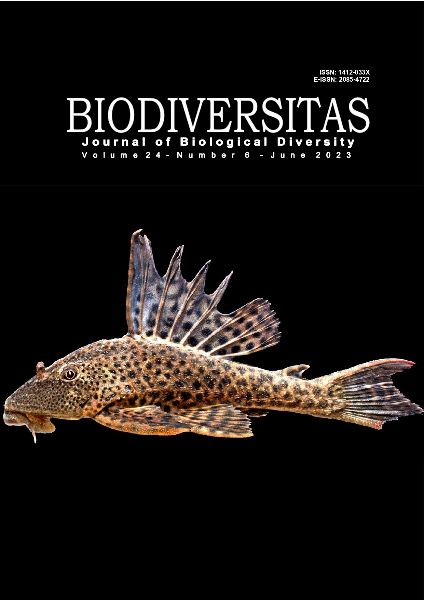Identification of Arbuscular Mycorrhizal Fungi associated with Arabica coffee root (Coffea arabica) in the Arfak Mountains region of West Papua, Indonesia
##plugins.themes.bootstrap3.article.main##
Abstract
Abstract. Suparno A, Prabawardani S, Nisa DK, Ruimassa RR. 2023. Identification of Arbuscular Mycorrhizal Fungi associated with Arabica coffee root (Coffea arabica) in the Arfak Mountains region of West Papua, Indonesia. Biodiversitas 24: 3207-3213. Coffee is a global commodity widely consumed as a beverage globally and has a high economy. Currently, the trend of drinking coffee is no longer dominated by older people but has become part of the millennial and celebrity lifestyle; therefore, worldwide demand for coffee continues to increase. Efforts to develop area expansion and productivity continue to be pursued. The Arfak Mountains Region of West Papua, located 800 - 2,500 m above sea level (masl), is a potential area for coffee plantations. The local farmers in this area have grown coffee independently and with gradual government support for the last years. Given the benefits of Arbuscular Mycorrhizal Fungi (AMF), which can increase plant growth and productivity, this study aims to identify the types of AMF that are associated with coffee plants in 4 districts, Mokwam, Anggi Giji, Anggi Gida, and Membey in Arfak Mountains region, West Papua. Identification of AMF types was observed based on the morphology of mycorrhizal spores. The research was conducted using the observation method with a purposive sampling technique from November 2022 to March 2023. Based on the observation, the coffee plants in 4 districts were associated with AMF. The types of AMF associated with coffee in Mokwam were more numerous than in other locations, namely the Acaulosporaceae Genus with five species, Glomeaceae Genus with five species, one species of Simiglomus sensu stricto, one species of Funneliformis sensu stricto, and one species of Septoglomus sensu stricto. AMF in Anggi Giji District consisted of Acaulosporaceae Genus with two species, Glomeaceae Genus with four species, while in Anggi Gida District consisted of Acaulosporaceae Genus with one species, Glomeaceae Genus with three species, one species Septoglomus sensu stricto. AMF species in the coffee plants of the Membey District are the Acaulosporaceae Genus with three species, the Glomeaceae Genus with two species, and one species of Septoglomus sensu stricto. From the soil analysis results, the soil fertility level is low; conversely, the mycorrhizal presence level is higher because of the more infertile soil, the more active mycorrhiza.

